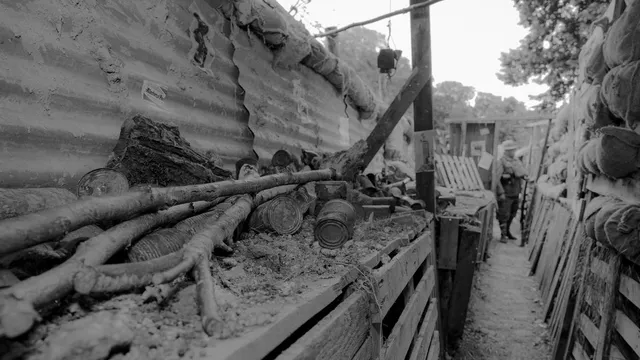
U.S. soldiers trapped by Germans in Argonne Forest fight for their lives
2025-01-04 00:00- Cher Ami was a male homing pigeon born in Norfolk, England, and served with the U.S. Signal Pigeon Corps during WWI.
- In September 1918, while the 77th Infantry Division was trapped by German forces in the Argonne Forest, Cher Ami successfully delivered critical messages despite being injured.
- Cher Ami's heroic actions helped save lives, leading to him receiving several posthumous honors, including the Croix de Guerre Medal and recognition at a D.C. ceremony.
Express your sentiment!
Insights
In the latter part of 1918, during World War I, U.S. infantrymen in northern France became trapped by German forces in the Argonne Forest. The 77th Infantry Division faced lethal assaults from both the enemy and friendly fire due to the lack of knowledge about their location. In this precarious situation, traditional communication methods struggled, leading to the deployment of messenger pigeons like Cher Ami, who was born in Norfolk, England, and assigned to the Signal Pigeon Corps. Despite the dangers, Cher Ami carried vital messages, including one stating the urgent medical needs of the platoon amidst confusion and chaos. Cher Ami's bravery was evident when he successfully delivered a crucial message even after being shot multiple times, resulting in injuries to his chest, leg, and loss of one eye. His enduring spirit and determination meant that he not only transmitted the voice of the lost soldiers but also helped to prevent further friendly fire, thereby saving countless lives. Cher Ami became a symbol of loyalty and service, highlighting the significant role animals played in warfare communication during this time. Following the war, Cher Ami was honored for his bravery, receiving the Croix de Guerre Medal as recognition of his heroic deeds. In 1931, he was inducted into the Racing Pigeon Hall of Fame, affirming his legacy within the community of homing pigeon racers. The 77th Infantry Division's use of pigeons for communication showcased an innovative approach to battlefield coordination, proving that these birds were reliable under extreme duress. Cher Ami, in particular, became a celebrated figure, illustrating a unique aspect of military history that is often overlooked. On November 2019, Cher Ami was posthumously awarded the Animals in War and Peace Medal of Bravery during a ceremony in Washington, D.C. He became one of the first recipients of this honor, solidifying his importance in both military history and the animal rights movement, as it raised awareness of the contributions made by animals in warfare. His incredible story serves as a powerful reminder of the sacrifices made by non-human agents in conflict and their vital roles in saving human lives.
Contexts
Messenger pigeons have played a significant role in military communication throughout history, particularly during times of war. Their use dates back to ancient civilizations, where they were first utilized by the Romans and Persians for sending messages over long distances quickly. The homing instinct of these birds allows them to return to their home lofts, which made them invaluable for communications, especially when other methods were slow or unreliable. The use of pigeons became more structured during the 19th century, especially during the Franco-Prussian War (1870-1871), where they carried messages across front lines, delivering critical information when traditional communication lines were cut off or disrupted. This marked the beginning of a more organized use of pigeons in military operations, leading to the establishment of breeding and training programs specifically for military purposes. During World War I, the military heavily relied on messenger pigeons for communication, as they were often more reliable than other forms of communication like telephones or telegraphs. With the chaos of warfare, including the destruction of communication lines, pigeons provided a reliable way to transmit urgent messages between units. Pigeon lofts were created in various locations, and each pigeon was assigned to a specific unit. The most famous of these pigeons was Cher Ami, who served with the American forces and is credited with saving the lives of nearly 200 soldiers by delivering an urgent message. Such acts not only showcased the effectiveness of using pigeons but also solidified their status as true heroes within military ranks. The technological advancements and the rise of radio communication in the following decades diminished the reliance on messenger pigeons in military operations. However, they continued to be used in various conflicts, proving their worth during World War II. Military organizations maintained and trained pigeons, which were utilized for intelligence gathering and carrying messages, especially in covert operations where stealth was paramount. Pigeon units were established, and they participated in various war efforts, with some birds even receiving medals for their bravery and service. Notably, during World War II, the British military employed pigeons for various missions, including dropping them behind enemy lines. Today, while messenger pigeons are no longer a mainstay in military communication, their historical significance cannot be overstated. The strategic value of pigeons during wartime laid foundational principles for modern communication methods in the military. Their legacy continues to be honored through various memorials and organizations dedicated to exploring their contributions, ensuring that the remarkable tales of these avian messengers remain a part of military history. The development of communication technology has rendered them obsolete in modern warfare, yet their story serves as a testament to the innovative methods employed by military forces to address the challenges of communication in critical situations.